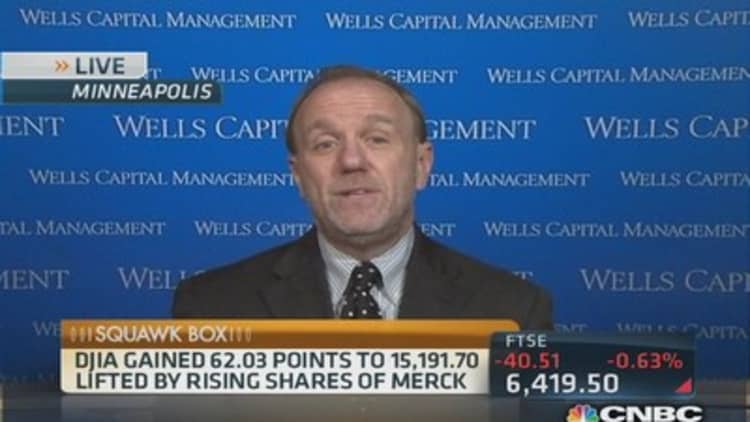Government shutdowns are bullish? That's been the history over the past 30-plus years, though there's always the possibility that this time could be different.
Since 1981, the law has required that whenever Congress fails to pass a budget on time the government has to shut down.
While the idea of a shutdown sounds ominous, markets historically have shrugged it off.
There even have been violent gains afterwards, such as the roaring rally that occurred after the Sept. 30, 1982 event. The S&P 500 ripped 12.7 percent higher in the next month.
(Read more: Avoid 'catastrophic'debt default: Erskine Bowles)
In fact, over the course of 11 shutdowns since Nov. 20, 1981, as first-year President Ronald Reagan squared off with Congress over taxing and spending, market reaction one month out has been negative only three times, according to Bank of America Merrill Lynch. Overall, the median gain has been 2.8 percent. (See chart)
True, there's probably not a lot of logic to it, other than a likely relief rally once the impasse gets resolved.
S&P 500 performance prior, during and subsequent to historical government shutdowns
| Shutdown* | Duration (days) | 1m prior | 2wk prior | During | 2wk after | 1m after |
|---|---|---|---|---|---|---|
| Sep 30, 1976 | 10 | 3.1% | -0.1% | -3.4% | -1.5% | -2.0% |
| Sep 30, 1977 | 12 | 0.2% | 0.1% | -3.2% | -1.2% | 2.7% |
| Oct 31, 1977 | 8 | -4.3% | -1.2% | 0.7% | 3.8% | 0.7% |
| Nov 30, 1977 | 8 | 2.4% | -0.6% | -1.2% | 1.1% | -3.2% |
| Sep 30, 1978 | 17 | -0.9% | -1.5% | -2.0% | -3.6% | -6.0% |
| Sep 30, 1979 | 11 | 0.3% | 0.5% | -4.4% | -3.8% | -0.9% |
| Nov 20, 1981 | 2 | 1.2% | -0.8% | -0.1% | 3.0% | 0.6% |
| Sep 30, 1982 | 1 | 2.3% | -2.7% | 1.3% | 9.5% | 12.7% |
| Dec 17, 1982 | 3 | -0.3% | -0.9% | 0.8% | 2.0% | 3.8% |
| Nov 10, 1983 | 3 | -4.8% | -0.3% | 1.3% | 0.0% | -2.0% |
| Sep 30, 1984 | 2 | -0.3% | -1.6% | -2.2% | 1.0% | 3.1% |
| Oct 3, 1984 | 1 | -2.5% | -2.7% | 0.1% | 3.2% | 3.6% |
| Oct 16, 1986 | 1 | 3.4% | 2.4% | -0.3% | 2.2% | -0.9% |
| Dec 18, 1987 | 1 | 1.5% | 11.3% | 0.0% | -0.8% | -2.6% |
| Oct 5, 1990 | 3 | -4.0% | 0.1% | -2.1% | 2.4% | 2.8% |
| Nov 13, 1995 | 5 | 1.3% | 1.6% | 1.3% | 1.2% | 2.0% |
| Nov 15, 1995 | 21 | 3.8% | 1.5% | 0.1% | -0.8% | 4.8% |
| Average | 6.4 | 0.1% | 0.3% | -0.8% | 1.0% | 1.1% |
| Median | 3.0 | 0.3% | -0.3% | -0.1% | 1.1% | 0.7% |
| Average since 1981 | 3.9 | 0.1% | 0.7% | 0.0% | 2.1% | 2.5% |
| Median since 1981 | 2.0 | 1.2% | -0.3% | 0.1% | 2.0% | 2.8% |
Source: Source: BofA ML US Equity & Quant Strategy, Strategy Snippet: The shutdown saga continues. Sept. 27, 2013
But most advisors are telling their clients essentially to ignore the noise in Washington and pay attention to a market that has surged nearly 20 percent in 2013.
Andrew Adams, a strategist at Raymond James, said investors should watch the charts: The has held its 50-day moving average support, while the small-cap-focused "is breaking out to new all-time highs."
(Read more: Ron Paul: GOP 'notserious' about spending cuts)
"By watching these charts and others, you can cut through the interminable noise that will continue to dominate the news and hopefully be prepared to profit while others are panicking," Adams said in a note to clients. "Remember, just because the government shutdown does not mean you should shut down your portfolio."

The wild card in this shutdown scare is the debt ceiling.
If the heretofore unthinkable happens and Congress does not extend the debt ceiling, meaning likely default for the U.S. and an almost-certain round of downgrades from the ratings agencies, that could change the dynamic considerably.
(Read more: The government shutdown probably kills 'Octaper')
"In the scenario where we move past the 'X' date and the Treasury misses a debt payment (maturing or coupon), we expect S&P to quickly move to the 'Selective Default' (SD) rating," BofAML rates strategist Ralph Axel said in a report. "Moody's and Fitch are likely to downgrade the rating by one notch, with the possibility that Fitch moves to 'Restrictive Default' if the default persists and several bonds are affected."
But the most likely case virtually across Wall Street, for now, appears to be a settlement with minimal financial market damage.
"We remain confident that while congressional leaders have been unwilling to compromise on the less risky shutdown question, they will do what is necessary on the debt limit," Goldman Sachs economist Alec Phillips said in a note. "In fact, it is our sense that part of the reason the shutdown has taken place is because congressional leaders knew a showdown would occur on one of the fiscal deadlines, and it was less risky to have a dispute on the spending bill than on the debt limit."
_ By CNBC's Jeff Cox. Follow him @JeffCoxCNBCcom on Twitter.






